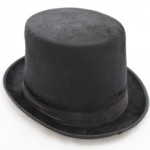 “She wore a raspberry beret…”
“She wore a raspberry beret…”
Prince, Raspberry Beret
Some of my favorite fictional characters are known for wearing distinctive hats. Dirk Gently (of Dirk Gently’s Holistic Detective Agency, by Douglas Adams) is described as wearing a dark red hat with a flat brim — “…an elegant adornment… if the wearer were a small bedside lamp, but not otherwise.” Moist von Lipwig (from Terry Pratchett’s novels Going Postal, Making Money, and the upcoming Raising Steam is more readily recognized by his hats than by his ordinary features — first a gold hat with wings, then a top hat covered in gold glitter. Sherlock Holmes is another hat person; his association with the deerstalker is so indelible that the BBC’s modern re-invention of the character (portrayed expertly by Benedict Cumberbatch) uses the hat in one episode as an attempted disguise. In each case, wearing a hat conveys something about the wearer: eccentricity, flamboyancy, confidence.
Accessories and other items of personal decoration can help paint a vivid picture of a character. This week, write a scene that uses one or more physical objects to define a character.
 “Words are very unnecessary /
“Words are very unnecessary /